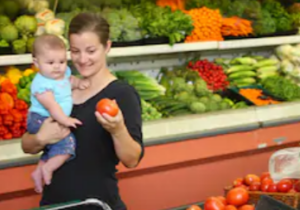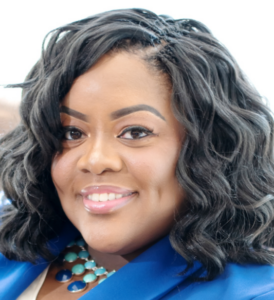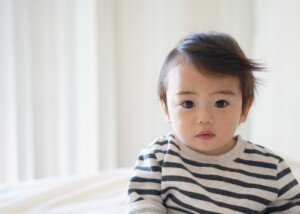
Have you noticed how common it is for parents to bring their babies into public buildings without their feet covered?
Ironically, if an adult is barefoot in a restaurant, he or she will be told by management to leave for this reason.
Though a parent may insist that their barefoot baby’s feet will never touch a public floor, since the baby is being carried or in a stroller, there are situations in which the feet will make contact with a dirty public surface.
For example, think of all the germs in that publically-used high chair at a diner that you put your baby in, or the diner’s chair or booth seat – that your baby’s bare feet come in contact with.
Predictably, your baby’s feet will then either eventually make direct contact with her mouth, or, she’ll play with her feet and then stick her fingers in her mouth.
This is almost akin to you yourself licking the diner seat.
“So we all know that ‘germs’ are everywhere and invariably, exposure to some amounts of bacteria and fungi is good for our innate immune system,” says Dr. Charnetta Colton-Poole, MD, a board certified pediatrician based in Atlanta, GA.
“However, some infectious particles can live on surfaces for two hours or longer. If you then touch that surface and then touch your eyes, nose or mouth, you are at risk for contracting that disease.”
Adults often take extra measures to prevent this from happening to them.
For instance, they will make use of the anti-bacterial moist towelettes offered at the Walmart entrance and wipe down the handle of their shopping cart before proceeding into the store.
They will sometimes just whip out one of these towelettes from their purse and wipe their hands.
Another tactic is to use a paper towel to grab the door handle in a public restroom upon existing.
Are these the same people who think nothing of not covering their baby’s feet in public?
Now if the public area is a beach or swimming pool, that’s one thing.
But the practice of leaving a baby’s feet uncovered is highly prevalent in shopping centers, restaurants and diners, airports, airplanes (tons of bacteria there!), auto dealerships, the post office – anywhere where the parent does business.
Dr. Colton-Poole continues, “So if someone with the flu sneezes, and those droplets land on a public high chair or grocery cart, and then your child puts their mouth on that surface, they are at risk for developing the flu.”
More likely, the baby or toddler will touch their feet, then put those fingers in their mouth, or rub an eye or stick a finger in the nose or ear. These openings are portals through which microbes can enter the body and cause an infection.
“Walking around barefoot (without open sores, wounds or cuts) doesn’t cause a high rate of bacterial infection, but in the pediatric population, babies put their feet in their mouth or they crawl on public floors and then put their hands in their mouth, and that can expose them to infection,” explains Dr. Colton-Poole.
“Generally, it is recommended that toddlers not walk around barefoot in public places like doctors’ offices or restrooms.”
These floors are among the most bacteria-laden, but don’t forget that any public floor or seat/chair with high traffic is.
In fact, don’t think for a second that there are far fewer germs on a public seat than on a floor.
Though a floor is far more likely to have unseen sharp debris that can puncture a baby’s skin, a chair (including its armrests) may very well have been spit upon, drooled upon, sneezed/coughed upon, urinated upon – and never once cleaned by the building’s cleaning crew.
“It is also of importance to note that walking around barefoot on wet surfaces can be associated with the development of fungal skin infections on the feet,” says Dr. Colton-Poole.
 With 15+ years in the medical field, Dr. Colton-Poole is also a medical communication strategist and content creator.
With 15+ years in the medical field, Dr. Colton-Poole is also a medical communication strategist and content creator.
 Lorra Garrick has been covering medical, fitness and cybersecurity topics for many years, having written thousands of articles for print magazines and websites, including as a ghostwriter. She’s also a former ACE-certified personal trainer.
Lorra Garrick has been covering medical, fitness and cybersecurity topics for many years, having written thousands of articles for print magazines and websites, including as a ghostwriter. She’s also a former ACE-certified personal trainer.
.

























